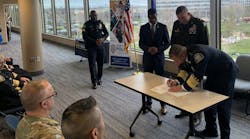In 1915 Dr. Walton Cannon, a Harvard University psychologist first used the term “fight or flight” in a critical incident. The term was coined in literature in 1929. During the past 100 years, research has uncovered the physical and mental reasons behind the fight-flight response. Additionally, science has confirmed a third “F” that actually preludes every fight or flight response.
Fright can be defined as fear excited by danger from something strange, sudden, or shocking; think sudden ambush.
All animals have an instinctual and biological reaction to fear; this includes all humans, even highly-trained soldiers and first responders. During a threatening event, real or perceived, the body is throw into an autonomic nervous system response to deal with that threat; commonly referred to as a hyperarousal state, acute stress response, or the "fight or flight" response.
Probably every tactical instructor you have ever heard has sung the "Fight or flight. Fight or flight. Fight or flight Song”. It is an easy catchy phrase that is now part of your subconscious mantra. Simple enough, one response or the other, right? You have a choice, engage or find cover (officers aren’t paid to run away). Only two ways it can go down. Not so fast. There is another vital “F-word” before either of those other two “F-words” can take place; and that is labeled “Freeze”. These three Fs are utterly and intrinsically connected to our survival responses.
Understanding the Freeze Response
While officers are trained how to act during a life/death situation; most average citizens are not. Therefore, the victim pool becomes much larger in a disaster such as a school shooting or a terrorist attack (such as the Pulse nightclub in Orlando).
During a critical incident, the body and the brain go into overdrive to preserve life. There is an immediate activation of a person’s sympathetic nervous system. The body is thrown into an urgent response from the adrenal medulla, the part of the brain that puts out adrenaline. The adrenal medulla does much more; it secretes epinephrine and norepinephrine, triggering the body to go into an alert mode in matter of seconds. As adrenaline rushes through the body, the muscles prepare for emergency action. Additionally, surface blood vessels constrict so that any bleeding will be minimized, vision heightens as pupils constrict, and breathing and heart rate accelerate as more oxygen is channeled to the muscles. All nonessential bodily processes cease. Sometimes, the body tries to decrease weight, urine and fecal contents are shed (hence the terms “scared shitless). During these physical changes, there is also a momentary freeze as the brain instantaneously discerns whether to fight or flee, or maybe a little of both.
Example 1: A woman is walking home after a night shift at the local supermarket. She lives nearby, but the street she lives on is not well lit. Suddenly she hears a startling noise. Without thinking, she stops dead in her tracks. Her senses become razor sharp, her eyes widen and scan the scene taking in as much visual information as possible. She may hold her breath in an unconscious effort to become completely silent and still; this also allows her hearing to be more acute and discriminating. She freezes, she looks like a deer in the headlights - a terrified human statue.
Example 2: A lone gunman, with an arsenal of weapons and ammunition, randomly starts shooting people in the bleachers at a high school basketball game. Many individuals run, some hide, and others simply fall to the ground and enter a semi-conscious catatonic trance even though they were not hit by any bullets.
Now as an officer, you are probably thinking: “fools, do something, run, hide, fight back, do something, anything” There is a general assumption that is always better to get a head start, dash away, or immediately confront the potential threat. However, that is not always the case. Freezing is a state of defensive preparation. Your body receives the same jolt of adrenaline freezing that it does readying you for fighting or fleeing. However, the brain has calculated that at least for that moment, your best odds of survival come with no action at all.
This freeze response occurs constantly in the wild. Many predators react to movement, so if the prey abruptly goes rigid there’s a chance that the bobcat they have sensed won’t notice them. Some animals take this to the extreme and play dead because most animals have an innate reluctance to eat something that is already dead. In fact, studies have concluded that the “freeze” factor prevented additional deaths during the 2007 Virginia Tech massacre.
The Realities of the 3 “F’S” for Law Enforcement Officers
So, you have three powerful instinctive urges in a life/death situation:
- Fight like hell
- Run like hell
- Freeze (as in Hell freezes over)
Fighting like hell is usually the best option, it is what you have trained for. But remember, the bad guy may be fighting like hell too. While you can use force, even deadly force, you can only use enough to stop the threat. You are expected to make an accurate threat assessment while fighting for your life.
Running like hell may be an appropriate response under certain situations. Find cover, ready any additional tactical equipment, seek back-up, alert other officers who are responding to the scene of the severity of the threat.
Freezing is not considered a good option for law enforcement officers, but it happens. Recent studies have encouraging news related to the freeze response in officers. This intrinsic, biological, mandatory ambush-freeze might only be one or more milliseconds.
Your reaction time depends on two key factors:
- How alert you were just before the surprise. Simply stated: Never Let Your Guard Down.
- How much practice you have had training for life/death events. Actions can become automatic (without conscious thought) with sufficient and repeated training. However, without this training, physical skills will probably not occur correctly under stress.
Freezing and Joe Citizen
The great majority of the public lack the mental conditioning and physical skills to adequately deal with any true life/death situation, especially in regards to violence. They simply do not have the tools or training to get past the freeze response in order to more immediately transition into the fight or flight response.
If you are given an opportunity while educating civilians about surviving active shooter situations, at the workplace or in schools, explain the importance of recognizing a freeze response, and the need to break free of that to trigger the fight or flight response. Panic can lead to paralysis, an inability to make appropriate life-saving decisions. Encourage practice with self-talk as well as physical skill training. The last thing anyone wants is more victims.


